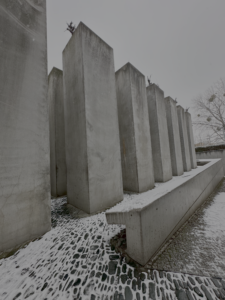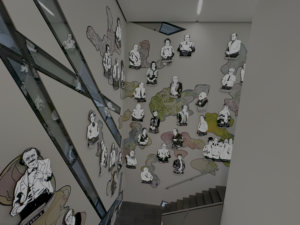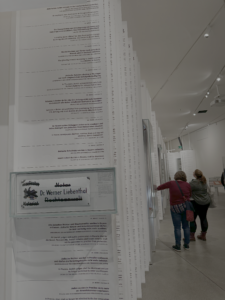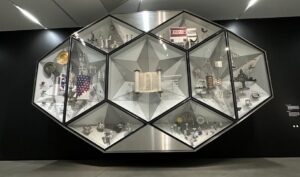Jewish Museum Berlin Part 2: The Main Exhibit and Conclusion
The Main Exhibition:

The main exhibition had two primary sections as well as numerous subsections. The two main exhibits included: Jewish Life in Germany: Past and Present and German Jews Today. After the Kafka exhibit, we first visited Jewish Life in Germany: Past and Present. This section covered topics surrounding Jewish life and culture, aligned with some history of the past and present. We saw great art pieces with visual, auditory, and experiential aspects, along with many artifacts, both recent and ancient. This section covered most of the museum, starting in the basement—with many slopes, turns, and architectural aspects designed to disorient visitors—and continuing on the second and first floors.

As you first walk down the stairs, you are greeted by multiple passageways leading in every direction. Walking down one will lead you in circles and eventually to the next corridor. As we walked around, we made our way to the Holocaust Tower, a 24-meter concrete silo with a sliver of light coming in through the top and muffled voices from outside. The silo was meant to evoke feelings of oppression and anxiety, and we would say it accomplished this, with the closed walls and the freezing room. Continuing through the corridors, we reached the Garden of Exile, where the ground was uneven cobblestone and slightly slanted. Tall concrete pillars surrounded us, and walking through was very disorienting, representing the uncertainty refugees often feel when moving to a foreign country. Along with the Holocaust Tower and the Garden of Exile, the basement hallways were lined with drawings created by people in concentration camps. Seeing these drawings was deeply powerful due to their realism of evident pain and suffering, and it was clear they were drawn with immense emotion.

We then made our way to the Axis of Continuity, where a long staircase led to the second floor—a light at the end of the tunnel. On the ground floor, we encountered a powerful art piece titled Shalekhet (Fallen Leaves), representing victims of war. This piece was housed within the Memory Void, a long, eerie corridor with high ceilings and stone walls. The art installation consisted of 10,000 metal faces of varying sizes and shapes, all spread across the floor for visitors to walk upon. From there, we proceeded to the second floor, where the main part of the museum was located.
During the main exhibition, we explored exhibits on Jewish culture and traditions. As we first entered, there was a room with verses from different prayers. It felt as if I had gone back to elementary school, sitting in Tefillah at Sunday school. Memories flooded back as we walked further into the area focused on Judaism through sound. Hearing the prayers and sounds of service felt welcoming, and despite being in another country on the other side of the world, everything still sounded the same. The next stop covered Jewish dietary laws. Though it was only a small wall in the museum, it was filled with information and varying views on kashrut. As people who keep kosher in our own ways, we appreciated seeing the diversity of practices, highlighting that being Jewish can look different for everyone.

Continuing through the museum’s winding paths, we were transported back in time to learn about Jewish history in Germany,starting from the days of the Germanic tribes. One hallway displayed quotes from famous individuals, and as we reached the end of the second floor, we descended a staircase lined with portraits of notable Jewish figures throughout history. It was fun to look around and recognize people we had heard of or learned about. There were also several figures I had never heard of before, but luckily, there was a book at the bottom of the stairs listing all their names.

On the first floor we continued making our way through history to the 1930s, one of the rooms had a massive list of all the laws and policies against Jews from 1930 to 1945. Walking in and seeing the list at first we did not realize what it was, but then it hit us and we were shocked. We knew there had been a lot of laws but we had never seen all of them written out in one place. As we walked through it was overwhelming seeing all the laws going into effect, removing rights one by one, making it impossible to even walk down the street without getting arrested. While walking through there was a display case of Judaica that had been stolen by the Nazis showing not only the loss of rights but also the theft of personal and cultural belongings.
At the end of this section, there was a large map of Europe that showed approximately the number of Jewish victims from each country compared to the Jewish population before the war. We definitely spent a few minutes just staring at the map, trying to fully comprehend the size of the numbers and the reach that the war had on the world. As we continued walking the path was a timeline of Jews in Europe after the war, showing communities starting over and slowly growing. We appreciated how the museum had all of the stats on a path that was lit up as if it were the light at the end of the tunnel.

Once we made it to the present day, there was a massive display case filled with Judaica, where we sat and just stared for a while. Pointing out different objects that we see often or even own, ends a great tour of a great museum. When reflecting on our time at the museum, we can conclusively say that it not only taught us a great deal about Judaism but also a lot about ourselves and our people. This museum brought up many memories for both of us, creating a truly magical experience that we will appreciate for the rest of our lives. We thoroughly enjoyed our time at this museum and all in all, as evidenced by our two-part blog post and four-plus hours at the museum itself.
Written by: Zach and Melissa
Jewish Museum Berlin. (n.d.). Jewish Museum Berlin. https://www.jmberlin.de/en
